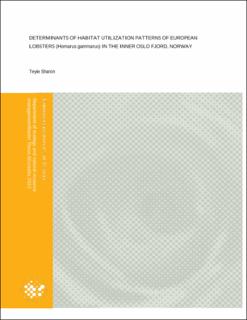| dc.description.abstract | Habitat type and structure influences diversity body size, recruitment, population size structure and survival of species in marine communities. There is, however, inadequate empirical evidence on what substitutes location-specific habitat structure as this tends to vary from one region to the other. This study was therefore carried out to analyze factors that determine habitat utilization patterns of European lobsters (Homarus gammarus) in the inner Oslo fjord, Norway. Capture-mark-recapture sampling method was employed. Data was collected in 3 seasons-September 2020, September 2021, and December 2021) in 4 zones (Middle, North, South and Northeast) for five days with 20 traps and a 24 hours soaking time. Results indicate that shallow marine hard bottoms had the most prevalent vegetation type in the fjord and the most preferred by both male and female lobsters. Zone S had the highest heterogeneity with nine out of ten benthic vegetation types. Depth utilization patterns for both male and female lobsters in the three seasons (September 2020, September2021 and December 2021) were highest between 10 m and 25 m.
Male lobsters had a positive preference for substrate grain sizes ranging between 5 - 120 mm, while females had a positive preference for grain size 120-200 mm. However, both male and female lobsters showed a negative selection ratio towards substrate grains < 5 mm. Both male and female lobsters had a negative selection ratio towards depth below 10 m. Males had a positive selection ratio towards depths of between 10 m to 20 m. Both sexes have a negative selection for depth >30 m. Catch Per Unit Effort (CPUE) decreased with depth in all zones and was highest in zones Middle and South at any depth compared to zones North and North East. They were, however, not statistically different (M and S) due to overlapping confidence bounds. Finally, this study found that depth is a major determinant in habitat utilization patterns of European lobsters. There are, however, other factors that are associated with this. Considering the differences in habitat preferences, management decisions made in line with what habitats are suitable for assigning sanctuaries should not be generalized and instead should be based on area specific data and research. | en_US |

